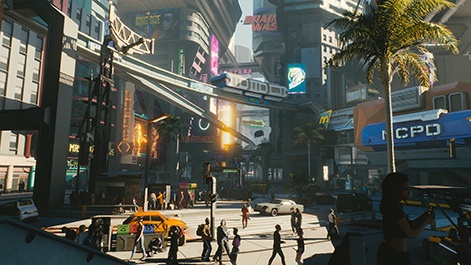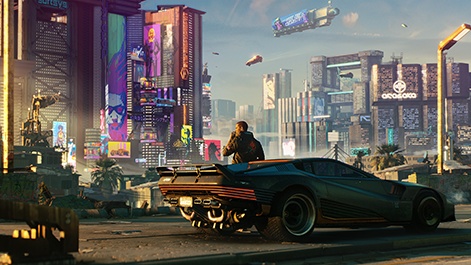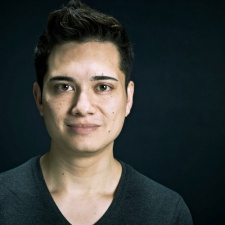Since E3 2018, it's hard to think of a game that has attracted such widespread excitement as CD Projekt's Cyberpunk 2077. Though the title was announced with a teaser trailer back in 2013, Cyberpunk 2077 was re-revealed in spectacular fashion at the end of Microsoft's conference. The following year, CD Projekt returned to Microsoft's stage again, this time bringing Matrix, Speed and John Wick star Keanu Reeves - who is lending his voice and likeness to the game - along for the ride.
It hasn't been all smooth sailing, though. Cyberpunk 2077 has attracted its fair share of controversy, with some saying that the game's handling of certain topics isn't as sensitive as they'd have hoped. We sat down with senior level designer Miles Tost at Gamescom 2019 to find out about CD Projekt's rollercoaster 14 months
It's fair to say that Cyberpunk 2077 is one of the games that consumers are most excited about right now. Being on the development team - and a rather public face at events like Gamescom where you're hosting demo sessions - is that a positive pressure or a negative one?
It depends on the time of day. Most often, it is a positive kind. It's sort of in a way what, at least personally, drives me. You see that people are so excited and you want to deliver to their expectations. The other half is that it's not just the pressure that's being brought on by the community and the fans, but also by ourselves as creators. That's actually something I really like about working at CD Projekt RED - we really strive to the highest-quality product that we can. For that, we put a lot of pressure on ourselves to be better. We iterate a lot. Each iteration makes the game better. That's something nice - we could just do something and then leave it.

You were a level designer on CD Projekt RED's previous game, 2015's The Witcher 3: Wild Hunt. How has development on Cyberpunk 2077 compared to that title?
There are many more people working on Cyberpunk 2077 compared to The Witcher 3. When I started at the company, we were around 150 people. Now we're 600 members of staff. The cool thing is that you can tell with the size is that the speed at which we can do things has dramatically increased. the quality of things as well. I would say that the gameplay we've shown so far is probably the most polished stuff we have ever made compared to the demos we showed for The Witcher 3, for example. Already these builds are much more stable. It really shows that we have a lot more experts and manpower to tackle these kinds of issues and that will have a really positive impact on the quality of the game.
Are there any lessons that the team took from its time developing Wild Hunt?
The big one is the experience we had from creating an open-world game. The Witcher 3 was the studio's first attempt at making an open-world game. If you do something for the first time you are able to bring fresh ideas to the fore. I'm seeing this as well with how we've approached the first-person perspective as well, for example. We've never made a first-person game before but as a result, we have come up with this super cool interactive dialogue system. The way we do first-person animation is something we're still learning but I think we've had some really cool and unique results from within that as well.
Getting back to the lessons learnt from open world, we actually refined the recipe we developed for an open world that we found with The Witcher 3 and its two expansions where we kept adding to that world. We also took all the lessons as to the density that feels good for players, as in how often users bump into something that you can interact with, like bandit camps or sunken treasures in The Witcher 3. We also learnt a lot about that even though a high density is nice, actually Blood and Wine's content is denser than the average density of The Witcher 3's open world, at the same time we need to balance with quantity. We remember the sunken treasures in Skellige, which people really didn't like all too much - that was almost a kneejerk reaction of us realising we might not have enough content, the sea is empty so let's just put something there as a last-minute thing. We realised that while the intent might have been noble, it really isn't about throwing loot around in how it was placed and the context of it. What we are doing with Cyberpunk for example is - and this is also part of the more complex or free gameplay we have - is that the open-world encounters have become more complex. They also feature multiple different approaches that you can do. We have these things that we call Street Stories which are miniature quests that don't necessarily standalone but help us to expand on the world and the lore. That's quite exciting. The big difference is that there's a huge variety of how you can tackle them in terms of gameplay. These are your playgrounds where the player can really use the skills that they have in a sandbox environment.
Being transgender is normalised in 2077. The citizens of Night City don't really care. In a world where you can do with your body whatever you want anyway, why would people care specifically about people being transgender at all?
When the cyberpunk genre first emerged with films like Blade Runner and books such as Neuromancer, the neon, ad-saturated worlds were meant to convey a sense of late capitalist oppression - it felt like couldn't escape it. Compare that something like Netflix's Altered Carbon and the cyberpunk aesthetic is being used more as set-dressing more than trying to convey anything. With 2077, you obviously have to try and stay true to the Cyberpunk 2020 tabletop game's aesthetic, but how have you tried to make that relevant for the current day?
It's quite fascinating. We have multiple angles from which we are approaching this topic. Firstly, the grand idea that we set up for ourselves is that bringing the punk back into cyberpunk. The grit and also the flashy visuals. Punk is coloured hair and all that. Then we also set out to define these four different art styles which are really the rulebook for how we visually design our world. They are Entropy, Kitsch, Neo-Militarism and Neo-Kitsch. For each of these, we ask: 'Okay, what is their motto?' With Entropy, for example, it might be 'necessity over style' - it's quite pragmatic. Then Kitch is 'Style over Substance'' - it's less to do with how well it works, as long as it's cool in how it looks. Neo-Militarism is this corporate style that is substance over style and then the art-style of the super-rich combines style and substance. All these styles have a demographic attached to them - we actually a whole history, when these styles emerged and why and it's tied to the background lore and why they exist in the world. We even have it down to what kind of materials you would expect - gadgets, for example, made in different styles and what they'd look like, what colour palettes we might use.
That basically allows us to take, for instance, your dictaphone here and imagine what it would look like in these four different styles. That's something we do - you'll be able to find four different versions of items within the world. It allows us to create a really fresh style but one that's also contextually bound to the world and the lore because we can say: 'We have a lot of Entropy stuff here - automatically it must be a poorer area'. If you're in that sort of place and find a super high-tech corporate phone that clearly is made in a Neo-Militaristic style, you can tell that something is fishy here as that shouldn't be here. Then the other aspect to this is we're not afraid to show our cyberpunk world during the day time. For us, the idea is that we want to portray the most believable world possible and part of that is still having a normal day and night cycle. Our world isn't shrouded in clouds and permanent darkness but you have to look at the day time. That's a very interest experiment because you look at it and ask how that changes how the city feels and what it looks like? How can you maintain it? With the light, suddenly it feels that the danger disappears but you try to keep this intensity that Night City has. People are afraid of the dark; it makes things mysterious. But Night City itself maintains its danger even during the day time. How do you portray that? It's also interesting to look at it and go: 'How do these run-down streets look? What are the people doing during the day time? And how does the world react to it?'. That's quite fascinating. It's these kinds of thoughts that push us to come up with new and fresh ideas.

Since Cyberpunk 2077 was re-revealed at E3 2018, people have been picking over the trailers, screenshots and demos CD Projekt has released for details. There have been accusations levelled at the game, including transphobia - over in-game advertising featuring a sexualised depiction of a transwoman in a screenshot - and racism, with some feeling that the portrayal of the Voodoo Boys and Animals gangs from the most recent gameplay demo leant rather heavily on racial stereotypes. It's been pointed out that - like The Witcher 3 - Cyberpunk 2077 is going to be an experience that's hundreds of hours long and that title dealt with sensitive subjects in an appropriate fashion. Is there any frustration with marketing a massive game like Cyberpunk 2077 and people drawing conclusions from the limited information out there?
I don't think so. It's odd because we can say there's no problem, right? We do ground these things, we do think these things through very thoroughly. So we actually are confident that people will be happy once the game ships and they'll realise that it's not that bad. We've actually gone out on record to explain a couple of these things. There was this ad where you could see this transgender woman in a very sexualised manner and we thought about this very long and hard and it fits into the world of Cyberpunk 2077. Ads these days are kind of like that, very objectifying and exploitative. With 2077, we're exaggerating all of that and imagining how much worse it will get in the future. All the ads in the game are pretty much terrible. Ultimately, being transgender is normalised in 2077 but it's being sexualised as if you would have a picture of a woman or a man now. The citizens of Night City don't really care. In a world where you can do with your body whatever you want anyway, why would people care specifically about people being transgender at all? I don't think that people will be disappointed when they see how we set up the world and how consistent it is with itself.
What lessons have you taken from the time since Cyberpunk 2077's re-reveal at E3 2018?
It's been pretty crazy actually. I don't think we could have anticipated how much excitement and buzz there'd be around the game. Even now, when I went to the public area, some people are queuing up for seven hours to see the demo. Many will know it's a 30-minute version of a demo they don't get to play. It's insane to me. I'm of course incredibly grateful and humbled by this. It just shows how extreme the hype around the game is almost. Again, that comes back to the first question - we're totally aware that we need to deliver.
















